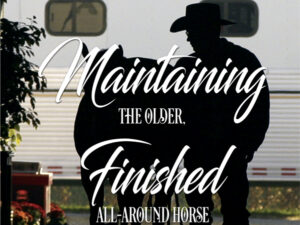Maintaining the Older, Finished All-Around Horse
Click here to read the complete article
498 – September/October, 2022
Owners and trainers of older, finished all-around horses have made incredible investments of time, effort, money and more into making their equine partners reliable and accomplished show mounts. Maintaining those seasoned horses to keep them sound, in shape, and ready to show well into their teens and beyond may seem like a daunting–perhaps even impossible–task, but it is possible with teamwork and thoughtful planning.
Here, three experts–an equine veterinarian, a long-time trainer, and AQHA Professional Horsewoman–came together to share their expertise in the exercise, nutritional, and other needs that are essential to maintaining those long-loved performance partners. More than any one factor, each expert delivered this message: a team approach to all-around health is imperative in older horses; this means that owner, trainer, veterinarian, dentist, and farrier–some may add a chiropractor and massage therapist to that list–must have a strong working relationship. Each person plays an integral role in the horse’s continued health and success, and the best outcomes occur when it’s a team effort.
Movement and Conditioning is Key
Arturuo Maestas of Maestas Show Horses has been training all-around horses for more than 25 years and has taken many from their futurity years into their teens. Among them include several Congress and World Champions. He has even shown several horses into their twenties.
“I’ve had the best luck with older horses by just making sure that they stay moving. Even if you have one that’s really trained and doesn’t need riding five days a week, make sure that it at least gets out five to six days a week,” Maestas says. With a laugh, he compares seasoned horses to himself, saying that on the rare occasion he may get to sit still for any period of time is when he has the hardest time increasing their activity level again. Stiffness sets in quickly and aches and pains seem to be accentuated.
Click here to read the complete article
498 – September/October, 2022











